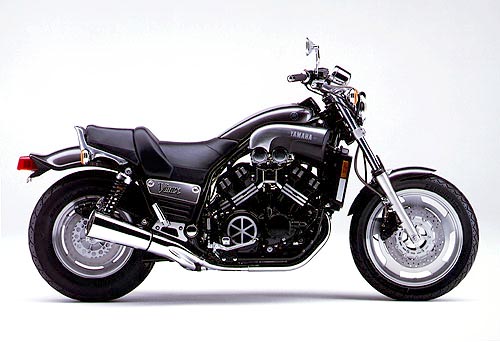
VMAX1200 stock specs (> '93): |
|
ENGINE: |
|
Type |
4-stroke, liquid-cooled, DOHC, 16-valve, 70-degree V-four |
| Displacement | 1198 cc |
Bore/Stroke (mm) |
76.0 x 66.0 |
Compression ratio |
10.5 : 1 |
Carburetor |
4 x 35 mm Mikuni CV with V-boost system. |
Power (HP @ the crank) |
145hp @ 9.000rpm |
Torque (Kg-m / ft-lbs) |
12.4kg-m / 80+ ft-lbs @ 6.000rpm |
Redline |
9.500rpm |
Transmission |
5-speed operated by hydraulic clutch, Shaft drive |
| Battery | 12 V, 16 AH |
Fuel tank |
15lts (including 3lts reserve) |
Average fuel economy |
8lts / 100km (I get 160km MAX until red light comes on) |
CHASSIS: |
|
Front suspension |
43 mm Kayaba forks. Preload adjustment (By air pressure). |
Rear suspension |
Dual Kayaba dampers Preload and damping adjustment. |
Front brake |
Two 298mm rotors with 4-pot calipers |
Rear brake |
|
Rake/Trail |
|
WHEELS/TIRES: |
|
Front wheel/tire |
18" x 2.15" with 110/90 V18 |
Rear wheel/tire |
15" x 3.50" with 150/90 V15 (Most of the 170/80 15" fit the Vmax rear wheel and look a lot better; just beware of "H" rating, up to 200Kph). |
WEIGHT: |
|
Dry / full |
262 kg / 280+ kg |
Power/Torque output: |
|
Power/Torque output from stock V-boosted Full power Vmax. There is a lot of arguing about Full power / non-Full power Vmaxes. (At least here in Portugal. You guys across the ocean only get Full power Maxes. Lucky bastards... :-) ) The only difference is that torque decreases quicker beyond 6.000rpm on NON-Full power Vmaxes, and therefore HP only reaches about 85 rear wheel HP. And why is that? Because of a little tiny system called V-boost, that Full power Maxes have, and non-Full power don't. And what the heck is a V-boost and how does it work?
"A small manifold-type connecting passage links each pair of left and right carburetors. A butterfly valve in the center of the passage remains closed below 6.000rpm, and each cylinder fills normally through a single 35mm carb. The magic begins at 6.000rpm, when the microprocessor-controlled servomotor (that's why when you turn on the key, you hear this bzzzz-bzzzz sound) begins to open the butterfly valve until its fully open at 8.000rpm. V-boost simply forces one cylinder to fill with a mix from 2 carbs. This simple supercharging effect is seen clearly on the dyno, where the Vmax power curve literally gets a second wind. It catches the motor right at its torque peak and carries it all the way to its 113.5 rearwheel hp peak." In MCN April 1997 Full power Vmaxes peak power is about 110-115rwhp, depending on bike, dyno, humidity, altitude, etc. but you get the picture... To see the visual diferences between 145HP and 100HP Vmaxes click below. And remember: HP at the crank (usually figures claimed by the factory) is NOT the same as HP at the rear wheel. HP at the wheel is less than HP at the crank. The transmission always eats up some HP, and even more in the case of drive shafts.
|
VMAX1200 Speed: |
|
| 1 / 4 mile | 10,94 sec. at 196,3 km/h |
| 0-100 km/h | 3,1 sec. |
| Top speed | 239+ km/h |